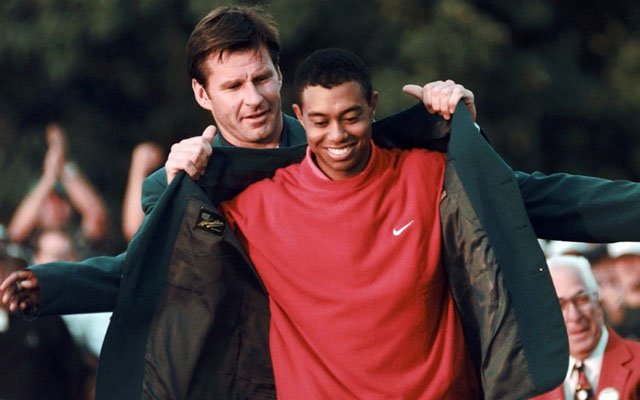Tiger’s master-class 20 years on


CROWNING MOMENT . . . A then young Tiger Woods receives the Masters green jacket from 1996 Masters golf champion Nick Faldo after Woods won the 1997 title
Iain Carter BBC Golf Correspondent
IT was standing room only. Reporters hung on every word uttered by sport’s newest sensation as he charmed everyone in that crammed interview tent.This was at Congressional Country Club, Bethesda, Maryland — the site of the 1997 US Open, the first major since the golfing world had been shaken up like never before.
Along with many members of the media contingent that week, it was my first encounter with Tiger Woods.
That day, at just 21 years of age, he demonstrated an uncanny maturity, an engaging demeanour, refreshing candour and the ability to look in the eye of every one of his inquisitors.
He talked about race relations, death threats, God and how he could no longer buy a sandwich in peace. There were a few questions about golf as well — he had, after all, recently won the Masters by a record 12 shots.
Not only that, he had become the first black man to triumph in the white-dominated environs of the Augusta National in Georgia. “As long as I’m alive, golfers will be white and caddies will be black,” the club’s co-founder Clifford Roberts had once infamously said.
Roberts died 20 years before Woods became the youngest to don a Green Jacket. He did so with the lowest score in the history of what had become golf’s most glamorous major.
It feels extraordinary to think that this seismic victory happened 20 years ago. The occasion is recalled, as part of our build-up to this year’s opening major of the season, in a BBC Radio 5 live special today at 11pm — Tiger’s Masterclass, 20 Years On.
So did he change the face of golf? “Yes, absolutely,” three times Masters winner Sir Nick Faldo tells the programme.
“Tiger helped so many parts of golf, he got people to sit up and take notice. He brought a lot of attention to it and a lot of clever people.
“And that’s why it’s moved on to where we are which is pretty amazing, the game of golf now,” he added.
Look at the players who dominate the game today – Dustin Johnson, Rory McIlroy and Jason Day – they possess the kind of athleticism that Woods first brought to the game.
The vast riches for which they compete are also thanks to the Tiger impact which fuelled inflated and lucrative television and sponsorship contracts.
Remembering 1997, Faldo provides notable insight because, as defending champion, he was drawn to play with Woods in the first round of that Masters. “It was the start of a monumental week,” the Englishman recalled.
“Media attention was off the charts, we’d never known or seen anything like that. He had already been able to orchestrate that he was different.
“That particular week it was constant media questioning. You were very lucky to get through one question about you before they wanted to start talking about Tiger.
“Everybody wanted to know about him.”
By the Sunday, the Englishman was slipping the Green Jacket onto the American’s youthful shoulders. “I was trying to be funny and I said ‘one word of advice, a red shirt clashes terribly with a green jacket’,” Faldo said.
“I whispered that in his ear but obviously the red shirt went on to become nearly as famous as the green jacket.”
Yet the tournament began inauspiciously for Woods as both he and Faldo struggled during the front nine of their opening rounds.
“I remember we looked at each other and raised eyebrows on the fifth green because the golf course was completely different,” said Faldo. “Boy, you went from green practice facilities and green greens and suddenly they were biscuit coloured.
“They were brutally hard and fast. And we didn’t see much of each other because we were both in the trees, probably left and right.
“We both shot 40 on the front nine so that was a pretty sombre sort of thing.”
On his way to the 10th tee, Woods, who had been joint favourite going into his first professional major, assessed what was going wrong. He vowed to shorten his backswing and his ball-striking suddenly became more reliable.
Woods birdied the 10th and chipped in for another at the short 12th. Another followed at the 13th and he reduced the par-five 15th to a short approach and successful eagle putt from three feet.
Faldo was the closest witness as Woods recorded that two-under-par round of 70. “He came back in 30 and that was the start,” said the six times major champion.
“And then we didn’t see him for dust for about the next 12 years.”
Woods followed up with rounds of 66, 65 and 69 to finish 18 under par. He took the lead on the 13th hole of his second round and was never caught. He ended up 12 strokes ahead of Tom Kite in second place.
It was the manner of the victory that was incredible. He averaged 323 yards off the tee and the longest club he hit into any of the par-four holes was a seven iron. It heralded the era of “Tiger-proofing” at the world’s greatest courses, Augusta included. Not that this hampered the young phenomenon.
The Masters of 1997 yielded the first of four Green Jackets (the same as Arnold Palmer, with only Jack Nicklaus ahead on six) and among 14 major titles for Woods, with the last coming at the 2008 US Open at Torrey Pines.
He won it on one leg before taking the familiar journey to the operating table as knee and back injuries savagely blighted his 30s and now early 40s.
There was also the scandal of his numerous extra-marital affairs that came to light on Thanksgiving night in 2009.
It was an epic fall from grace, but long before then Woods had become guarded and suspicious of the media and all who threatened his privacy.
Looking back at that 1997 news conference at Congressional, it is hard to reconcile the reclusive, wary figure of today with the youthful engagement he demonstrated on that occasion.
“My life is different for a 21 year old,” he stated. “But, then again, there are some perks to being who I am. I get to travel all around the world.
“I get to play golf every day, and doing the things I like to do. And I wouldn’t trade that for the world.”
But there were signs of how the burden of becoming the world’s most famous sportsman would weigh heavy. “What do I miss most? I guess playing a practice round in peace,” he said.
“Going out to dinner and people are bugging you. People want an autograph when you have food in your mouth.
“Where I was raised, that was very rude to bug someone while they eat. In our society now, it is different.”
Woods went on to say: “Another thing that’s changed dramatically in my life is, I guess, the nitpicking of what I do, all the actions that I take. People look at them and they critique them.
“And, sometimes that’s good. Sometimes that’s bad.”
Now, scrutiny surrounds his fitness and faltering recovery from multiple back surgeries which has limited him to just three competitive rounds this year.
He pulled out of the Arnold Palmer invitational earlier in March saying he had “no timetable” for his return. This year’s Masters starts on Thursday, 6 April.
Woods is now 41 years old, and in athletic terms, an elderly 41. “He’s obviously really struggling now,” Faldo observed.
“His thoracic spine is just not mobile enough and it probably does not have the residual strength to last. I think he is a long way off coming back to winning again. Majors are well and truly out of the window.
“It would be an unbelievable achievement if he could rebuild.”
He faces physical challenges that may prove insurmountable, but from the very start, Woods found ways to defy the odds.
The events at Augusta 20 years ago and their impact will never be forgotten.









Comments